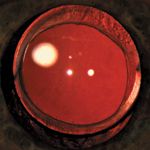Article
Sharp-edged IOL helps prevent PCO, investigators report
Vienna, Austria—A sharp posterior optic edge design seems to be superior to a double round optic edge design in preventing posterior capsule opacification (PCO). Investigators reported significantly less PCO at 1, 2, and 3 years after implantation of the Sensar OptiEdge AR40e IOL compared with the Sensar AR40 model (both from AMO).

Both types of PCO, regeneratory and fibrotic, were seen significantly less with the sharp-edged IOL at all three time points, according to Wolf Buehl, MD. The regeneratory type, by far the more common of the two, results from the presence of migratory residual lens epithelial cells that proliferate between the posterior capsule and the IOL. The fibrotic type of PCO is the result of transdifferentiated lens epithelial cells that originated in the anterior capsule and migrated into the posterior capsule. The authors published their findings in the Journal of Cataract and Refractive Surgery (2005;31:954-961).
Fifty-three patients who were to undergo bilateral cataract surgery were included in this study. The Sensar OptiEdge AR40e IOL was implanted in one eye and the Sensar AR40 IOL in the fellow eye. All patients underwent a conventional phacoemulsification procedure and were examined at 1 week, 1 and 6 months, and 1, 2, and 3 years after the surgery. The amounts of regeneratory and fibrotic PCO were graded on scales of 0 to 10 and 0 to 3, respectively. The investigators also measured the best-corrected visual acuity and the patients were asked to report any visual symptoms that caused problems. In addition, digital retroillumination images of the posterior capsule were obtained at every follow-up visit.
Long-lasting reduction of PCO
The results indicated that the implantation of the sharp-edged posterior optic resulted in "not only delayed development of PCO but also a long-lasting reduction of PCO, based on an observation period of 3 years," the investigators reported.

The eyes that had the AR40 IOL implanted had a significantly higher rate of neodymium (Nd):YAG laser capsulotomy. One eye in that group underwent capsulotomy before the 1-year follow-up examination and another underwent the procedure before the 2-year examination. At the 3-year time point, 12 eyes in that group required capsulotomy compared with only one eye in the AR40e group that required capsulotomy at that time point (p < 0.01).

Newsletter
Don’t miss out—get Ophthalmology Times updates on the latest clinical advancements and expert interviews, straight to your inbox.
2 Commerce Drive
Cranbury, NJ 08512
All rights reserved.





